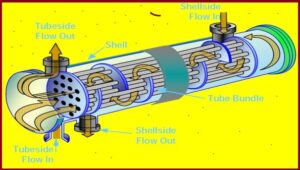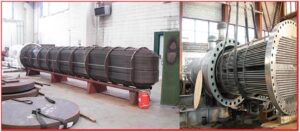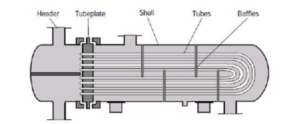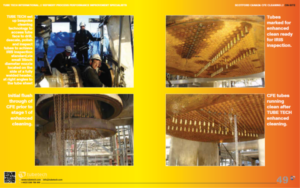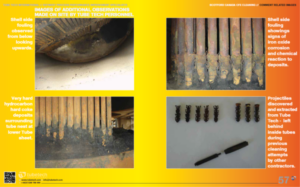5 Types of Shell and Tube Heat Exchangers and How They Work
Introduction
Shell and tube heat exchangers are the most widely used and are among the most effective means of heat exchange. A shell and tube heat exchanger is a device where two working fluids exchange heat by thermal contact using tubes housed within a cylindrical shell. The fluid temperature inside the shell and tube are different and this temperature difference is the driving force for temperature exchange. Used for wide temperature and pressure range, Shell and tube heat exchangers are compact in design, simple in construction and maintenance and provide excellent heat exchange.
Fig. 1 – Typical working principle of a shell and tube heat exchanger
The above figure shows both tube-side inlet and outlet nozzles in the front header. That means this exchanger consists of an even number of tube passes. However, there can be an odd number of tube passes. In that situation, the outlet nozzle will be on the header at the opposite end. Increasing the number of tube passes increases the heat transfer co-efficient. To increase the fluid turbulence, baffles are installed. This increases the heat transfer between the fluids.
1. Shell and Tube Heat Exchanger Bundle
Fig. 2 – Typical tube bundle of a shell and tube heat exchanger
N.B. Tube bundles are removed during maintenance.
2. Fixed Tube Heat Exchanger
Fig. 3 – Example of a typical fixed tube heat exchanger
The tube sheet is fixed in the shell by welding and hence the term fixed tube sheet exchanger applies. This simple and economical construction allows cleaning of the tube bores by mechanical or chemical means.
3. Floating Head Removable Bundle Heat Exchanger
Fig. 4 – Example of a typical Floating Head Removable bundle heat exchanger
In floating head construction, the rear header can float or move as it is not welded to the shell. The tube bundle can easily be removed during maintenance.
4. U-Tube Heat Exchanger
Fig. 5 – Typical representation of U-tube Heat exchanger
U-tube exchangers are a type of shell and tube heat exchanger whose tube bundle is made of continuous tubes bent into a “U” shape. The bend side is free-floating and this helps in thermal expansion without requiring expansion joints. However, such bends are difficult to clean.
Shell & Tube Heat Exchangers find their application in the following industries: Refinery, Petrochemical, Fertilizer, Oil and Gas, Chemical, Power Plants. Their configuration may be horizontal, as shown in the above, or vertical – VCFE (Vertical Combined Feed Exchangers), as shown below.
5. Texas Towers/ Vertical Combined Feed Exchangers (VCFEs)
Images from a TubeTech™ post-job report, showing tubeside and sheetside fouling in a Texas Tower/ Vertical Combined Feed Exchanger (VCFE).
TubeTech™ are also industry leaders in the cleaning and inspection of TWISTED TUBE heat exchangers by Koch Heat Transfer Company. Find out more about this service, here.
Contact our team today for expert advice and tailored solutions across a range of industries and applications.

